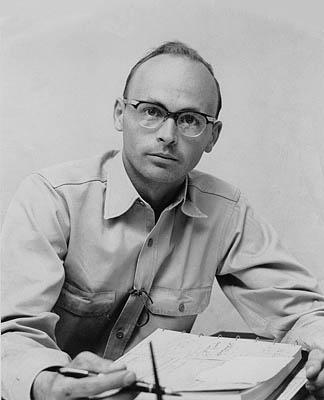Charles Augustus Steen (December 1, 1919 – January 1, 2006) was a geologist who made and lost a fortune after discovering a rich uranium deposit in Utah during the uranium boom of the early 1950s.
Charles Augustus (Charlie) Steen’s discovery of pitchblende in the Chinle formation in southeastern Utah’s Big Indian District changed the course of the U.S. uranium industry by proving that large, high-grade uraninite ore deposits could be found on the Colorado Plateau. Charlie Steen’s discovery helped ignite the 1950s uranium boom and made the impoverished prospector-geologist a wealthy and world-famous figure.
In 1943, Charlie Steen graduated from the Texas College of Mines and Metallurgy at El Paso. He worked as a petroleum geologist in Bolivia and Peru before he began his determined search for uranium in 1949. Together with his wife, M.L., and four young sons, Charlie endured years of privation and hardship while he prospected the remote and desolate canyons and mesas of the Colorado Plateau. Charlie’s four-year quest for uranium was not an erratic wandering but was based on his original geologic theory that uranium would be found concentrated along the flanks of anticlinal structures.
In 1951, Charlie Steen was drawn to the Lisbon Valley anticline, where low-grade uranium occurrences in the Cutler formation attracted his attention. Although the area had been condemned as uneconomic by government experts, Charlie figured the better grade uranium would be encountered down-dip and further back from the meager rim outcrops. During the spring of 1951, he staked twelve claims covering this ground.
After raising a grubstake and obtaining a dilapidated, second-hand drilling rig from Bill McCormick, Charlie Steen had a four-mile road built into his property, and in July 1952, started drilling on his Mi Vida claim. At a depth of 70 feet, the drill cored through 14 feet of a dark-colored sandstone unit in the Chinle Formation that proved to be the first commercial discovery of uraninite ore in the United States. After staking more claims, Charlie sank a shaft near his discovery drill hole and mined the first of more than 10 million tons of uranium ore, worth more than $1 billion, produced from the Big Indian District during the next 30 years.
Charlie Steen’s rags-to-riches saga caught the imagination of the press and public, and he became famous as the country’s Uranium King. In 1953, Charlie and Bill McCormick bought the Big Buck claims for $2 million and formed the Standard Uranium Corp. to exploit the ore body adjacent to the Mi Vida Mine. In 1955, Charlie and Bill formed the Uranium Reduction Company and built the first privately financed uranium mill in the United States. Charlie sold the Mi Vida Mine and his interest in the Uranium Reduction Company to the Atlas Corporation in 1962.
Charlie Steen’s venturesome nature and a series of bad investments cost him most of his fortune, and a serious head injury curtailed his prospecting career. In 1992, the town of Moab, Utah, honored Charlie and M.L. Steen with a celebration to mark the fortieth anniversary of Charlie’s discovery and to recognize their many contributions to the Moab area.
https://www.mininghalloffame.org/hall-of-fame/charles-augustus-steen
